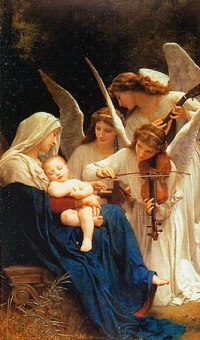I know it sounds silly, but the Bible is making a Catholic comeback!
Now, for 2,000 years of standing firm & holding fast to the traditions by word & by letter (c.f., 2 Thess 2:15), the Church has drawn its very breath from the abiding presence of Christ Jesus in the Scriptures, but the average Catholic of the past few generations perhaps has not. Catholics need to learn their Bible, & when the Faithful - who alredy possess the fullness of the truths of the Faith - are further energized with the Word of God in the Scriptures, what a force for spreading the Gospel will they be!
The Church has provided us with wonderful resources & tools for immersing ourselves faithfully in the Holy Writ. On the U.S. Bishops' web site is this helpful list of points to more fully engage the Scriptures, where Christ Jesus himself waits to meet us:
1. Bible reading is for Catholics. The Church encourages Catholics to make reading the Bible part of their daily prayer lives. Reading these inspired words, people grow deeper in their relationship with God and come to understand their place in the community God has called them to in himself.
2. Prayer is the beginning and the end. Reading the Bible is not like reading a novel or a history book. It should begin with a prayer asking the Holy Spirit to open our hearts and minds to the Word of God. Scripture reading should end with a prayer that this Word will bear fruit in our lives, helping us to become holier and more faithful people.
3. Get the whole story! When selecting a Bible, look for a Catholic edition. A Catholic edition will include the Church's complete list of sacred books along with introductions and notes for understanding the text. A Catholic edition will have an imprimatur notice on the back of the title page. An imprimatur indicates that the book is free of errors in Catholic doctrine.
4. The Bible isn’t a book. It’s a library. The Bible is a collection of 73 books written over the course of many centuries. The books include royal history, prophecy, poetry, challenging letters to struggling new faith communities, and believers’ accounts of the preaching and passion of Jesus. Knowing the genre of the book you are reading will help you understand the literary tools the author is using and the meaning the author is trying to convey.
5. Know what the Bible is – and what it isn’t. The Bible is the story of God’s relationship with the people he has called to himself. It is not intended to be read as history text, a science book, or a political manifesto. In the Bible, God teaches us the truths that we need for the sake of our salvation.
6. The sum is greater than the parts. Read the Bible in context. What happens before and after – even in other books – helps us to understand the true meaning of the text.
7. The Old relates to the New. The Old Testament and the New Testament shed light on each other. While we read the Old Testament in light of the death and resurrection of Jesus, it has its own value as well. Together, these testaments help us to understand God’s plan for human beings.
8. You do not read alone. By reading and reflecting on Sacred Scripture, Catholics join those faithful men and women who have taken God’s Word to heart and put it into practice in their lives. We read the Bible within the tradition of the Church to benefit from the holiness and wisdom of all the faithful.
9. What is God saying to me? The Bible is not addressed only to long-dead people in a faraway land. It is addressed to each of us in our own unique situations. When we read, we need to understand what the text says and how the faithful have understood its meaning in the past. In light of this understanding, we then ask: What is God saying to me?
10. Reading isn’t enough. If Scripture remains just words on a page, our work is not done. We need to meditate on the message and put it into action in our lives. Only then can the word be “living and effective.”(Hebrews 4:12).
Friday, July 17, 2009
Subscribe to:
Comments (Atom)
